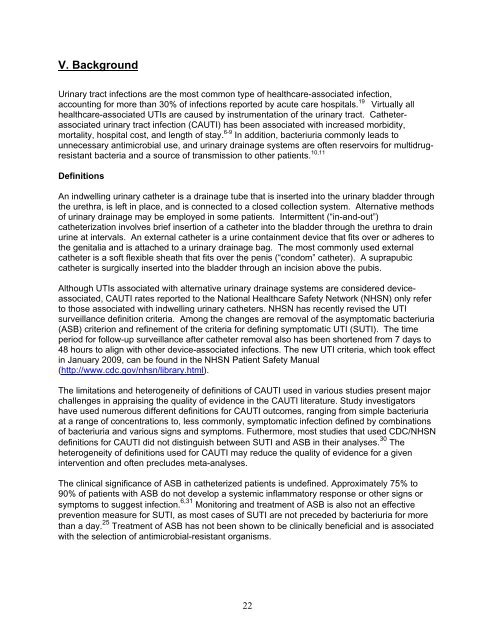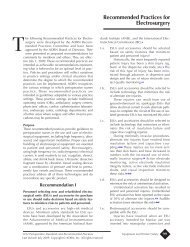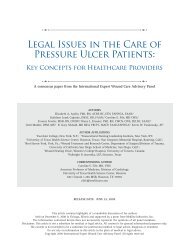V. BackgroundUrinary tract infections are the most common type of healthcare-associated infection,accounting <strong>for</strong> more than 30% of infections reported by acute care hospitals. 19 Virtually allhealthcare-associated UTIs are caused by instrumentation of the urinary tract. Catheterassociatedurinary tract infection (<strong>CAUTI</strong>) has been associated with increased morbidity,mortality, hospital cost, <strong>and</strong> length of stay. 6-9 In addition, bacteriuria commonly leads tounnecessary antimicrobial use, <strong>and</strong> urinary drainage systems are often reservoirs <strong>for</strong> multidrugresistantbacteria <strong>and</strong> a source of transmission to other patients. 10,11DefinitionsAn indwelling urinary catheter is a drainage tube that is inserted into the urinary bladder throughthe urethra, is left in place, <strong>and</strong> is connected to a closed collection system. Alternative methodsof urinary drainage may be employed in some patients. Intermittent (“in-<strong>and</strong>-out”)catheterization involves brief insertion of a catheter into the bladder through the urethra to drainurine at intervals. An external catheter is a urine containment device that fits over or adheres tothe genitalia <strong>and</strong> is attached to a urinary drainage bag. The most commonly used externalcatheter is a soft flexible sheath that fits over the penis (“condom” catheter). A suprapubiccatheter is surgically inserted into the bladder through an incision above the pubis.Although UTIs associated with alternative urinary drainage systems are considered deviceassociated,<strong>CAUTI</strong> rates reported to the National Healthcare Safety Network (NHSN) only referto those associated with indwelling urinary catheters. NHSN has recently revised the UTIsurveillance definition criteria. Among the changes are removal of the asymptomatic bacteriuria(ASB) criterion <strong>and</strong> refinement of the criteria <strong>for</strong> defining symptomatic UTI (SUTI). The timeperiod <strong>for</strong> follow-up surveillance after catheter removal also has been shortened from 7 days to48 hours to align with other device-associated infections. The new UTI criteria, which took effectin January <strong>2009</strong>, can be found in the NHSN Patient Safety Manual(http://www.cdc.gov/nhsn/library.html).The limitations <strong>and</strong> heterogeneity of definitions of <strong>CAUTI</strong> used in various studies present majorchallenges in appraising the quality of evidence in the <strong>CAUTI</strong> literature. Study investigatorshave used numerous different definitions <strong>for</strong> <strong>CAUTI</strong> outcomes, ranging from simple bacteriuriaat a range of concentrations to, less commonly, symptomatic infection defined by combinationsof bacteriuria <strong>and</strong> various signs <strong>and</strong> symptoms. Futhermore, most studies that used CDC/NHSNdefinitions <strong>for</strong> <strong>CAUTI</strong> did not distinguish between SUTI <strong>and</strong> ASB in their analyses. 30 Theheterogeneity of definitions used <strong>for</strong> <strong>CAUTI</strong> may reduce the quality of evidence <strong>for</strong> a givenintervention <strong>and</strong> often precludes meta-analyses.The clinical significance of ASB in catheterized patients is undefined. Approximately 75% to90% of patients with ASB do not develop a systemic inflammatory response or other signs orsymptoms to suggest infection. 6,31 Monitoring <strong>and</strong> treatment of ASB is also not an effectiveprevention measure <strong>for</strong> SUTI, as most cases of SUTI are not preceded by bacteriuria <strong>for</strong> morethan a day. 25 Treatment of ASB has not been shown to be clinically beneficial <strong>and</strong> is associatedwith the selection of antimicrobial-resistant organisms.22
EpidemiologyBetween 15% <strong>and</strong> 25% of hospitalized patients may receive short-term indwelling urinarycatheters. 12,13 In many cases, catheters are placed <strong>for</strong> inappropriate indications, <strong>and</strong> healthcareproviders are often unaware that their patients have catheters, leading to prolonged,unnecessary use. 14-16 In acute care hospitals reporting to NHSN in 2006, pooled mean urinarycatheter utilization ratios in ICU <strong>and</strong> non-ICU areas ranged from 0.23-0.91 urinary catheterdays/patient-days.17 While the numbers of units reporting were small, the highest ratios were intrauma ICUs <strong>and</strong> the lowest in inpatient medical/surgical wards. The overall prevalence of longtermindwelling urethral catheterization use is unknown. The prevalence of urinary catheter usein residents in long-term care facilities in the United States is on the order of 5%, representingapproximately 50,000 residents with catheters at any given time. 18 This number appears to bedeclining over time, likely because of federally m<strong>and</strong>ated nursing home quality measures.However, the high prevalence of urinary catheters in patients transferred to skilled nursingfacilities suggests that acute care hospitals should focus more ef<strong>for</strong>ts on removing unnecessarycatheters prior to transfer. 18Reported rates of UTI among patients with urinary catheters vary substantially. National datafrom NHSN acute care hospitals in 2006 showed a range of pooled mean <strong>CAUTI</strong> rates of 3.1-7.5 infections per 1000 catheter-days. 17 The highest rates were in burn ICUs, followed byinpatient medical wards <strong>and</strong> neurosurgical ICUs, although these sites also had the fewestnumbers of locations reporting. The lowest rates were in medical/surgical ICUs.Although morbidity <strong>and</strong> mortality from <strong>CAUTI</strong> is considered to be relatively low compared toother HAIs, the high prevalence of urinary catheter use leads to a large cumulative burden ofinfections with resulting infectious complications <strong>and</strong> deaths. An estimate of annual incidence ofHAIs <strong>and</strong> mortality in 2002, based on a broad survey of US hospitals, found that urinary tractinfections made up the highest number of infections (> 560,000) compared to other HAIs, <strong>and</strong>attributable deaths from UTI were estimated to be over 13,000 (mortality rate 2.3%). 19 And whilefewer than 5% of bacteriuric cases develop bacteremia, 6 <strong>CAUTI</strong> is the leading cause ofsecondary nosocomial bloodstream infections; about 17% of hospital-acquired bacteremias arefrom a urinary source, with an associated mortality of approximately 10%. 20 In the nursing homesetting, bacteremias are most commonly caused by UTIs, the majority of which are catheterrelated.21An estimated 17% to 69% of <strong>CAUTI</strong> may be preventable with recommended infection controlmeasures, which means that up to 380,000 infections <strong>and</strong> 9000 deaths related to <strong>CAUTI</strong> peryear could be prevented. 22Pathogenesis <strong>and</strong> MicrobiologyThe source of microorganisms causing <strong>CAUTI</strong> can be endogenous, typically via meatal, rectal,or vaginal colonization, or exogenous, such as via contaminated h<strong>and</strong>s of healthcare personnelor equipment. Microbial pathogens can enter the urinary tract either by the extraluminal route,via migration along the outside of the catheter in the periurethral mucous sheath, or by theintraluminal route, via movement along the internal lumen of the catheter from a contaminatedcollection bag or catheter-drainage tube junction. The relative contribution of each route in thepathogenesis of <strong>CAUTI</strong> is not well known. The marked reduction in risk of bacteriuria with theintroduction of the sterile, closed urinary drainage system in the1960’s 23 suggests theimportance of the intraluminal route. However, even with the closed drainage system,23
- Page 4 and 5: AcknowledgementHICPAC thanks the fo
- Page 6 and 7: AbbreviationsADLAPACHE IIASAASBBUNC
- Page 8 and 9: I. Executive SummaryThis guideline
- Page 10 and 11: II. Summary of RecommendationsTable
- Page 12 and 13: II. Proper Techniques for Urinary C
- Page 14 and 15: 1. If obstruction is anticipated, c
- Page 16 and 17: a. Procedure-specific guidelines fo
- Page 18 and 19: III. Implementation and AuditPriori
- Page 20 and 21: IV. Recommendations for Further Res
- Page 24 and 25: acteriuria inevitably occurs over t
- Page 26 and 27: VII. MethodsThis guideline was base
- Page 28 and 29: Figure 2: Results of the Study Sele
- Page 30 and 31: After determining the GRADE of the
- Page 32 and 33: Category I recommendations are defi
- Page 34 and 35: VIII. Evidence ReviewQ1. Who should
- Page 36 and 37: Evidence Review Table 1B. What are
- Page 38 and 39: Very low-quality evidence suggested
- Page 40 and 41: Q2B.2. Hydrophilic catheters vs. st
- Page 42 and 43: For all comparisons, we considered
- Page 44 and 45: a. Clamping vs. free drainage prior
- Page 46 and 47: studies. 3,25,260-276 The findings
- Page 48 and 49: 2D.5. Maintain unobstructed urine f
- Page 50 and 51: 15. Jain P, Parada JP, David A, Smi
- Page 52 and 53: 44. Chaudhuri P, Vengadasalam D. Ur
- Page 54 and 55: 71. Kelleher RE, Meeropol E, Parks
- Page 56 and 57: 101. Hirsh DD, Fainstein V, Musher
- Page 58 and 59: 132. Van Nagell, JR, Penny RM, Rodd
- Page 60 and 61: 163. Lai KK, Fontecchio SA, Lai KK,
- Page 62 and 63: 193. Waites KB, Canupp KC, Armstron
- Page 64 and 65: 222. Cohen A. A microbiological com
- Page 66 and 67: 253. Chavigny KH. The use of polymi
















